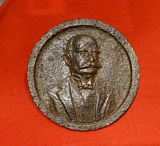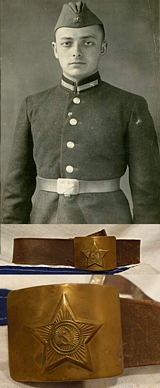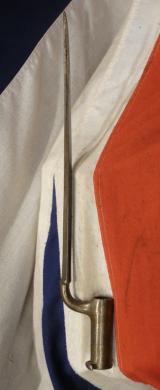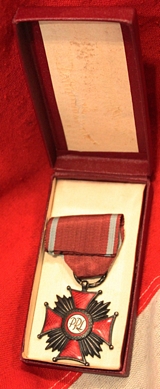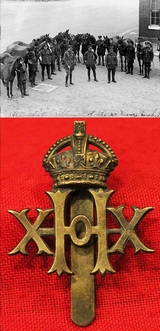A Very Good WW1 Gloucester Regt. Sterling Silver & Blue and White Enamel Military Sweetheart Brooch
The Gloucestershire Regiment was an infantry regiment of the British Army. Nicknamed "The Glorious Glosters", the regiment carried more battle honours on their regimental colours than any other British Army line regiment. During the course of the war, the regiment raised 25 battalions, seeing service on the Western Front, Gallipoli, Macedonia, Mesopotamia, Persia and Italy. Battle Honours gained in WW1; The Great War (25 battalions): Mons, Retreat from Mons, Marne 1914, Aisne 1914 '18, Ypres 1914 '15 '17, Langemarck 1914 '17, Gheluvelt, Nonne Bosschen, Givenchy 1914, Gravenstafel, St Julien, Frezenberg, Bellewaarde, Aubers, Loos, Somme 1916 '18, Albert 1916, '18, Bazentin, Delville Wood, Pozi?res, Guillemont, Flers-Courcelette, Morval, Ancre Heights, Ancre 1916, Arras 1917 '18, Vimy 1917, Scarpe 1917, Messines 1917 '18, Pilckem, Menin Road, Polygon Wood, Broodseinde, Poelcappelle, Passchendaele, Cambrai 1917 '18, St Quentin, Bapaume 1918, Rosi?res, Avre, Lys, Estaires, Hazebrouck, Bailleul, Kemmel, B?thune, Drocourt-Qu?ant, Hindenburg Line, ?p?hy, Canal du Nord, St Quentin Canal, Beaurevoir, Selle, Valenciennes, Sambre, France and Flanders 1914?18, Piave, Vittorio Veneto, Italy 1917?18, Struma, Doiran 1917, Macedonia 1915?18, Suvla, Sari Bair, Scimitar Hill, Gallipoli 1915?16, Egypt 1916, Tigris 1916, Kut al Amara 1917, Baghdad, Mesopotamia 1916?18, Persia 1918 read more
85.00 GBP
Superb WW1 Slouch Hat Badge of the 5th Mounted Rifle Ortago Hussars
A super original badge of one of the great and heroic New Zealand Horse Regiments. Probably for officers as it is gilded and manufactured with a separate silver central shield attached. Bears a small makers affixed label, Gaunt of London. The Otago Mounted Rifle Regiment was a New Zealand Mounted Regiment formed for service during the Great War. It was formed from units of the Territorial Force consisting of the 5th Mounted Rifles (Otago Hussars) the 7th (Southland) Mounted Rifles and the 12th (Otago) Mounted Rifles. They saw service during the Battle of Gallipoli, with the New Zealand Mounted Rifles Brigade and was later withdrawn to Egypt. They later left the brigade and served in served in France with the New Zealand Division becoming the only New Zealand Mounted troops to serve in France. Battle of Gallipoli
Battle of Flers - Courcelette. 15-22 Sep 1916.
Battle of Morval. 25-28 Sep 1916.
Battle of Le Transloy. 1-18 Oct 1916.
Battle of Messines. 7-14 Jun 1917.
Battle of Polygon Wood. 26 Sep - 3 Oct 1917.
Battle of Broodseinde. 4 Oct 1917.
Battle of Passchendaele. 12 Oct 1917.
Battle of Arras. 28 Mar 1918.
Battle of the Ancre. 5 Apr 1918.
Battle of Albert. 21-23 Aug 1918.
Battle of Bapaume. 31 Aug - 3 Sep 1918.
Battle of Havrincourt. 12 Sep 1918.
Battle of the Canal du Nord. 27 Sep - 1 Oct 1918.
Battle of Cambrai. 8-9 Oct 1918.
Pursuit to the Selle. 9-12 Oct 1918.
Battle of the Selle. 17-25 Oct 1918.
Battle of the Sambre. 4 Nov 1918, including the Capture of Le Quesnoy. read more
295.00 GBP
A Cast Iron Plaque of Graf Von Zeppelin The Pioneer of German Airship Travel, & The First To Realise The Potential of Airship’s Ability of Bombing Combat Against Cities Far Behind Enemy Lines
Dated 1920. Count Ferdinand von Zeppelin (German: Ferdinand Adolf Heinrich August Graf von Zeppelin; 8 July 1838 – 8 March 1917) was a German general and later inventor of the Zeppelin rigid airships. His name soon became synonymous with airships and dominated long-distance flight until the 1930s. He founded the company Luftschiffbau Zeppelin.
Ferdinand von Zeppelin served as an official observer with the Union Army during the American Civil War. During the Peninsular Campaign, he visited the balloon camp of Thaddeus S. C. Lowe shortly after Lowe's services were terminated by the Army. Von Zeppelin then travelled to St. Paul, MN where the German-born former Army balloonist John Steiner offered tethered flights. His first ascent in a balloon, made at Saint Paul, Minnesota during this visit, is said to have been the inspiration of his later interest in aeronautics.
Russet finish overall. Approx 4 inches read more
45.00 GBP
A 19th Century Indian Percussion Howdah Pistol, Double Over and Under Barrelled
With steel barrels and engraved decorative brass frame, and of overall utility quality. Tight mainspring action. Large .6 inch bore
A Formidable and singularly impressive double barrel large bore pistol, for use when seated in the Howdah, when riding on an Elephant, for protection against Tiger attack. The name "Howdah pistol" comes from the sedan chair- known as a Howdah which is mounted on the back of an elephant. Hunters, and officers, especially during the period of the British Raj in India, used howdahs as a platform for hunting wild animals and needed large-calibre side-arms to protect themselves, the elephant, and their passengers from animal attacks at close range. Even though Howdah pistols were designed for use in the “gravest extreme” against dangerous game (such as tigers), they were used in combat by some officers, for both offence and defence, as their effectiveness was simply unrivalled in close quarter action. Demand for these potent weapons outstripped supply, and many seen still surviving today are in fact converted shotguns, with shortened barrels and pistol grip restocking, and in later years gunmakers responded with revolvers, in calibres as large as .500, in order to fill the need. Firearms like these were one source of inspiration for the overtly powerful .44 magnum revolver. A 1996 movie, called 'The Ghost and the Darkness', starring Michael Douglas, featured the Douglas character, Charles Remington, using a near identical "howdah" pistol in several scenes.
Being of utility functional design this is not a fine quality English made equivalent from the same era, however, due to this, it is priced accordingly, and approximately less than a quarter of the price we sold our last two fine English made examples for. One nipple is only partially present
As with all our antique guns no license is required as they are all unrestricted antique collectables read more
675.00 GBP
A Superb Napoleonic French 'Prisoner-of-War' Portable Travelling Dressing Case, Shaped in the Form of a Book
In wood covered in straw-work parquetry. crafted by a prisoner of war during the1793 - 1815 War between Napoleon's French Navy and the Naval forces of King George III of England. This piece was hand crafted by a captive, French, master artisan who created this unbelievably detailed box with nothing but coloured pieces of straw, paper and scraps of wood, {often taken from their bunks} for a frame, and boiled glue. This piece would have taken weeks to hand create, and the tiny pieces of straw are somehow cut into thousands of minuscule pieces and assembled in tiny multicoloured geometric patterns. A very similar example to one that is on display in the Burghley House Collection. Made by the captured Napoleonic and French wars French Prisoners-of-War in the early 1800's in order to subsidise their meagre prison rations, and this fine piece is made to give the impression it is a sizeable book when closed. The interior bears two small sections, lidded compartments with interior mirror in Georgian Vauxhall plate, and a geometric parquetry All of the interior straw-work is pristine in colour and unfaded showing wonderful contrasts.
Great Britain was at war with France continuously from 1793 to 1802. Hostilities ceased briefly in 1802, but conflict soon recommenced. The Napoleonic Wars continued until 1815, when Napoleon?s forces were finally defeated at Waterloo.
For example,iIn 1796 the first prison to house French prisoners was built at Norman Cross, some 5 miles north of Peterborough. Conditions must have been both harsh and crowded; disease killed more that 1,700 inmates between 1797 and 1814.
To supplement their rations and to provide small income, some prisoners made ornaments, models and toys, which they were allowed to sell. The materials used included straw, wood, bone and even human hair. Many of the items made were extraordinary in their complexity and design and were always very desirable to collectors. The proximity of Burghley House to the camp meant that members of the Cecil family acquired many fine examples.
Those displayed at Burghley include a number of containers made of wood with applied decoration of coloured straw, a stationery box, a set of bone spillikins in a pocket case, a framed straw-work picture of the house built for Napoleon Bonaparte on St Helena, to where he was exiled, a bone set of dominoes and playing cards and a detailed model of an 80-gun ship-of-the-line with hair rigging..
Two photos in the gallery are of New Cross market for the French POWs to sell their wears and hand made pieces to the locals and nobility who used to travel to such markets to buy these pieces that were incredibly popular with members of the aristocracy and high society. a a painting of a prison hulk in Sheerness, often made from the hulks of a scrapped old British man o'war, or a captured, damaged French or Spanish frigate, read more
465.00 GBP
An Original, Patriotic War Period Infantryman’s, Red Army Russian Service Belt From A WW2 Veteran
Just acquired from it's original owner who served in the USSR's Red army in WW2 and in the early Cold War Era. This was his Red Star service belt that he wore, and another belt we show in the gallery was from his comrade who served in the USSR navy [now sold]. With it's original leather belt. A most scarce original example straight from it's original owner. The Red Workers' and Peasants' Army was the name given to the army and the air force of the Russian Soviet Federative Socialist Republic and from 1922 the Union of Soviet Socialist Republics. It was established in the immediate period after the 1917 October Revolution (Red October or Bolshevik Revolution), when the Bolsheviks constituted an army during the Russian Civil War opposite the military confederations (especially the combined groups summarized under the preamble White Army) of their adversaries. From February 1939, the Red Army, who together with the Soviet Navy, embodied the main component of the Soviet Armed Forces, took the official name "Soviet Army" until its dissolution in December 1991. read more
125.00 GBP
A Rare 1840 Constabulary Carbine Bayonet with Deep Defensive Sword Cut
With spring recess in the blade no spring. The most amazing feature of this bayonet is that it has parried a sword thrust, which has deeply cut into the blade elbow. A fabulous battle scar that undoubtedly saved the mans life. The socket is numbered 60. Ordnance stamped blade
The British pattern 1840 Constabulary carbine was known in to distinct patterns. the earlier carbine was derived from the Pattern 1839 Musket, and the later carbine followed the lines of the pattern 42 musket. The main differences being the lock, side plate and bayonet catch. The earlier pattern using the P'39 lock, New Land Pattern side plate and the Hanoverian bayonet catch, while the later used the P'42 lock, Lovell cups and the Lovell bayonet catch. The Pattern 1840 Constabulary Carbine has a 26" barrel and the rear sling swivel is placed at the underside of the butt, rather than at the trigger guard.
The Pattern 1840 Constabulary Carbine was issued in NSW, Victoria, Tasmania, and Western Australia read more
220.00 GBP
An Antique 'Claw and Feather' Bronze Paper Knife or a “Unicorn” Page Turner.
Originally classified in the collecting world as a late Victorian page turner, yet in fact it may well not be a mythical collectible, or so-called ‘unicorn piece’, but thus actually a rare form of paper knife.
A most interesting piece for the bibliophile. In colour patinated bronze, possibly Austrian. Circa late 1800’s. 9.5 inches long.
Uncut pages were common to Victorian Era and earlier books, artifacts of the bookbinding practices of the day. As Spellerberg explains in Reading & Writing Accessories, long sheets of paper were folded numerous times to form a “signature” of pages or “leaves,” which would be printed on both sides. Signatures would be printed, collated, and then bound (which usually meant “sewn”) to create a book. “Most of the leaves were cut during the binding process,” he writes. “However, since all books were bound by hand at that time, leaves were sometimes left uncut and could not be opened unless they were cut.” Paper-knives made such books readable.
It wasn’t just books that required paper-knives to be read, which is why the tools came in all sizes. There were long ones for newspapers and magazines, as well as shorter ones for diminutive books made to fit in the palm of the hand. Regardless of their size, some were painted in handsome designs while others were carved and fitted with sterling-silver handles, transforming these prosaic implements of paper destruction into small works of art. And, of course, a great many paper-knives were treated as handheld advertisements, sold at tourist destinations as souvenirs or given away by companies wishing to extend their brands, as we might put it today.
Impossibly so, as it turns out: After researching the topic for several years, Spellerberg concluded that page turners simply did not exist during the Victorian Era. In fact, according to Spellerberg, page turners didn’t exist during any historical period at all, making them the unicorns, if you will, of office collectibles, mythical objects that tell us more about how we imagine people lived rather than how they actually did.
Page turners, then, were actually paper-knives, and paper-knives were the tools readers employed to get at the content inside an “unopened” book.
Matthew Haley of Bonhams, stated. “I was once told, but have never confirmed, that people still occasionally request books that have never been opened at the Bodleian Libraries in Oxford,” Haley says. “They are lent a paper-knife for the purposes of cutting the pages.” In fact, as Rosie Burke of the Bodelian told me via email, “I’m pleased to confirm that it is true that after all these years we still have many books with uncut pages—either completely uncut or only partially cut. Staff will issue paper-knives to readers for certain books, but anything that is particularly old or fragile will only be cut by either reading-room staff or a member of our conservation team.”
This is obviously good news for readers—as a library, the Bodelian is in the business of spreading knowledge rather than keeping it secreted within the uncut pages of the books on its shelves. But the utility of paper-knives raises an interesting dilemma for book collectors. Is a book with uncut pages more valuable than a comparable volume whose leaves have been sundered, however carefully, by a paper-knife?
“Generally speaking,” Haley says, “there is a slight premium placed by collectors on uncut or ‘unopened’ copies, as they are closer to how the book would have been originally supplied by the bookseller. It’s one of the fascinating ironies of book collecting,” he adds, “that an unreadable book could be worth more than one that’s ready to read.”
Some years ago we had an early edition of Darwin’s ‘On the Origin of Species’ from Winston Churchill’s personal library, and many pages were still uncut, which demonstrates that despite being an early edition from the mid 19th century it had neither been read or even cut by Spencer Churchill or Winston Churchill during their ownership read more
220.00 GBP
A Polish Republic Order Of Merit Medal with Miniature in Original Box
Originated in 1923. At the time of its establishment in 1923, the Cross of Merit was the highest civilian award in Poland. It was awarded to citizens who went beyond the call of duty in their work for the country and society as a whole. May be awarded twice in each grade to the same person. 1950's PRL centre read more
110.00 GBP
Edward VIIth 20th Hussars Cap Badge, Used in WW1
The regiment was not deployed to South Africa until December 1901 for service in the Second Boer War and therefore only took part in the final drives against the Boer commandos in spring 1902. The regiment was based in Ireland again from 1908 to 1911.
The regiment, which was based in Colchester at the start of the First World War, landed in France as part of the 5th Cavalry Brigade in the 2nd Cavalry Division in August 1914 for service on the First World War. The regiment saw action at the Battle of Mons in August 1914 and both the First Battle of the Marne and the First Battle of the Aisne in September 1914. It went on fight at the First Battle of Ypres in October 1914, the Battle of Arras in April 1917 and the Battle of Cambrai in November 1917. It later took part in the German Spring Offensive in 1918, the Battle of Amiens in August 1918 and the final push as the war drew to a close read more
65.00 GBP




